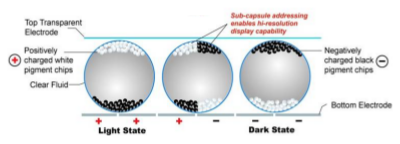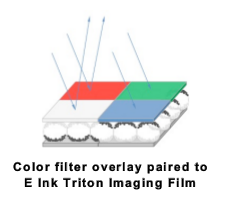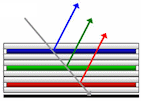Original URL: https://www.theregister.com/2010/11/14/colour_e_books/
Multi-colour e-ink to splash down in six months?
Red and yellow and pink and glee (eventually)
Posted in Personal Tech, 14th November 2010 09:00 GMT
Electronic ink is going colour - but you should probably wait a bit for your rainbow-friendly e-reader.
A year ago we looked at e-ink technologies, and suggested it would be 2011 before we saw colour e-ink devices on the shelves. On this occasion it seems we got it about right; though if you can wait until the latter part of the year, and are prepared to pay for it, then you'll get video as well, as e-ink and traditional technologies get closer together in good ways and bad.
On Tuesday E-Ink Corporation demonstrated its Triton colour screen technology, as well as announcing the first device to use it - from Hanvon and priced at around $440 for a 10-inch colour screen that only consumes power while its being updated. But Qualcomm would have us wait until January for the first product using its own technology, despite demonstrating it more than a year ago.
E-ink screens rely on reflected light, so work better in bright sunlight than under the covers; most of them can't be back-lit even if it were desirable, so a reading lamp is essential. They are also static - once an image is displayed it remains, as opposed to the constantly-updating LCD or CRT technology that can make even modern screens uncomfortable to use for long periods.
For an electronic ink technology, the most important factor is how much light the screen can reflect, or absorb on the black bits, and even modern electronic ink tends to be grey-and-slightly-darker-grey rather than black-and-white. The speed with which the screen can update is also important for usability, and overly-reflective glass can affect the users' experience too, but it is colour that everyone has been waiting for.
E-ink isn't just a technology, it's also the name of the E-Ink Corporation. Their greyscale screens already adorn e-book readers from just about everyone.
The latest incarnation, the E Ink Pearl, can be seen offering much better contrast in Amazon's Kindle 3, as well as Sony's latest generation of readers, though it still works on the same principle as earlier designs: tiny beads that are raised or lowered within a pixel to make white or black dots (or slightly raised to make grey):

The beads are suspended in goo, driven to the top by an electrostatic charge
Adding colour to that process is difficult, but can be done by putting different coloured filters on top of adjacent pixels. Make the pixels small enough and the human eye will blur them together to make colours defined by the relative brightness of the sub-pixels, which is what the E Ink Corporation's latest "Triton" screen that was demonstrated last week does:

The pixels are so small that they blur together
Obviously this reduces one's resolution by four, but that might be an acceptable price to pay for colour, which is hard to achieve any other way.
Fujitsu's FLEPia screens, which were already available a year ago, do work another way, using three layers to reflect one colour each:

Pushing light through all those layers makes for a dull screen
That's great, but the light loses a lot of brightness going through all those layers, and having to refresh each layer separately makes pushes the latency up to eight seconds (yes: in full-colour mode the FLEPia screen can take eight seconds to redraw).
Which brings us to Mirasol: Qualcomm's technology which in the last year has moved from a concept, to prototypes, to production, with a device announcement from an unnamed partner promised at CES in January. Mirasol uses the same sub-pixel technique as E-Ink, but instead of black beads in white goo it changes the distance between a mirrored plate and colour filter to trap light of the wrong wavelength:

This is a blue pixel, obviously
So instead of being reliant on the reflectivity of the white goo, as the Triton screen is, Mirasol is as bright as the mirrored surface underneath is reflective. Not only that, but because it moves plates up and down, rather than shifting beads suspended in goo, it has a much higher refresh rate that enables it to comfortably show video while still consuming a fraction of the power used by a traditional screen.
We've seen a Mirasol screen in action, several times, and it's bloody impressive; but with the prototype more than a year old it's not clear why we don't already have Mirasol displays yet.
Qualcomm hasn't explained, though it has started manufacturing 5.7-inch screens, presumably at the behest of that unnamed partner. 5.7-inches isn't going to give the iPad any cause for concern, and if the technology is as scalable as Qualcomm keeps telling us it is (ideal for Tvs, and all sorts, we're told) then why start with such a small size?
It seems likely the problem is price, which may trump contrast and refresh rate as the most important factor affecting colour electronic ink. Improvements in LCD technology, and better batteries, are pushing electronic ink aside in tablets, and starting to push into electronic book readers too.
The promise of a screen that consumes no power and when idle, and has no flicker, is attractive, but making users pay for it is another matter entirely. So if you want colour in your e-book then you'll have to pay for it, or just buy a LCD tablet and read in the dark instead. ®